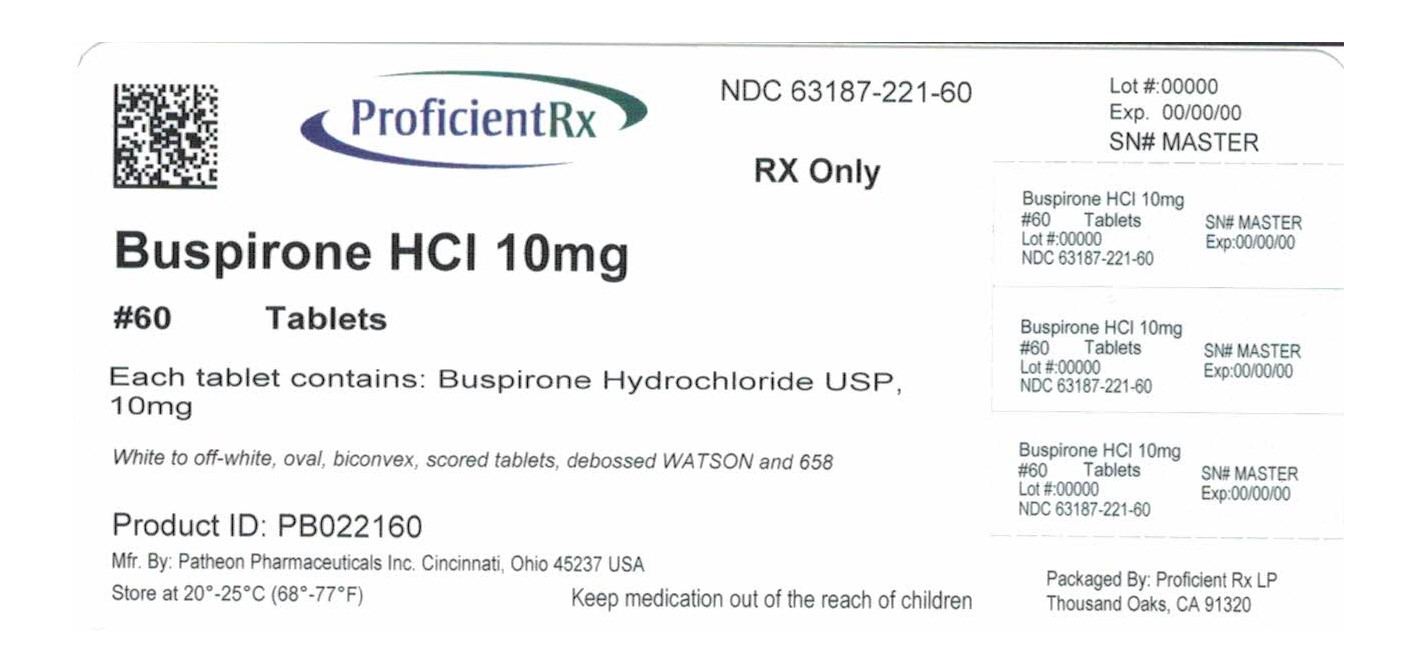Buspirone Hcl Recall
Get an alert when a recall is issued.
Questions & Answers
Side Effects & Adverse Reactions
The administration of buspirone to a patient taking a monoamine oxidase inhibitor (MAOI) may pose a hazard. There have been reports of the occurrence of elevated blood pressure when buspirone has been added to a regimen including an MAOI. Therefore, it is recommended that buspirone not be used concomitantly with an MAOI. Because buspirone has no established antipsychotic activity, it should not be employed in lieu of appropriate antipsychotic treatment.
Legal Issues
There is currently no legal information available for this drug.
FDA Safety Alerts
There are currently no FDA safety alerts available for this drug.
Manufacturer Warnings
There is currently no manufacturer warning information available for this drug.
FDA Labeling Changes
There are currently no FDA labeling changes available for this drug.
Uses
Buspirone hydrochloride tablets are indicated for the management of anxiety disorders or the short-term relief of the symptoms of anxiety. Anxiety or tension associated with the stress of everyday life usually does not require treatment with an anxiolytic.
The efficacy of buspirone has been demonstrated in controlled clinical trials of outpatients whose diagnosis roughly corresponds to Generalized Anxiety Disorder (GAD). Many of the patients enrolled in these studies also had coexisting depressive symptoms and buspirone relieved anxiety in the presence of these coexisting depressive symptoms. The patients evaluated in these studies had experienced symptoms for periods of 1 month to over 1 year prior to the study, with an average symptom duration of 6 months. Generalized Anxiety Disorder (300.02) is described in the American Psychiatric Association’s Diagnostic and Statistical Manual, lll1 as follows:
Generalized, persistent anxiety (of at least 1 month continual duration), manifested by symptoms from three of the four following categories:
1.
Motor tension: shakiness, jitteriness, jumpiness, trembling, tension, muscle aches, fatigability, inability to relax, eyelid twitch, furrowed brow, strained face, fidgeting, restlessness, easy startle.
2.
Autonomic hyperactivity: sweating, heart pounding or racing, cold, clammy hands, dry mouth, dizziness, lightheadedness, paresthesias (tingling in hands or feet), upset stomach, hot or cold spells, frequent urination, diarrhea, discomfort in the pit of the stomach, lump in the throat, flushing, pallor, high resting pulse and respiration rate.
3.
Apprehensive expectation: anxiety, worry, fear, rumination, and anticipation of misfortune to self or others.
4.
Vigilance and scanning: hyperattentiveness resulting in distractibility, difficulty in concentrating, insomnia, feeling “on edge”, irritability, impatience.
The above symptoms would not be due to another mental disorder, such as a depressive disorder or schizophrenia. However, mild depressive symptoms are common in GAD.
The effectiveness of buspirone in long-term use, that is, for more than 3 to 4 weeks, has not been demonstrated in controlled trials. There is no body of evidence available that systematically addresses the appropriate duration of treatment for GAD. However, in a study of long-term use, 264 patients were treated with buspirone for 1 year without ill effect. Therefore, the physician who elects to use buspirone for extended periods should periodically reassess the usefulness of the drug for the individual patient.
History
There is currently no drug history available for this drug.
Other Information
Buspirone hydrochloride is an antianxiety agent that is not chemically or pharmacologically related to the benzodiazepines, barbiturates, or other sedative/anxiolytic drugs.
Buspirone hydrochloride is a white crystalline, water soluble compound with a molecular weight of 422.0. Chemically, buspirone hydrochloride is 8-[4-[4-(2-pyrimidinyl)-1-piperazinyl]-butyl]-8-azaspiro[4.5]decane-7,9- dione monohydrochloride. The empirical formula C21H31N5O2 • HCl is represented by the following structural formula:
Each tablet for oral administration containing 5 mg, 10 mg, or 15 mg of buspirone hydrochloride USP (equivalent to 4.6 mg, 9.1 mg, and 13.7 mg of buspirone free base respectively). The 5 mg and 10 mg tablets are scored so they can be bisected. Thus, the 5 mg tablet can also provide a 2.5 mg dose, and the 10 mg tablet can provide a 5 mg dose. The 15 mg tablet is provided in a special tablet design. This tablet is scored so it can be either bisected or trisected. Thus, a single 15 mg tablet can provide the following doses: 15 mg (entire tablet), 10 mg (two thirds of a tablet), 7.5 mg (one half of a tablet), or 5 mg (one third of a tablet). In addition, each tablet contains the following inactive ingredients: colloidal silicon dioxide, lactose monohydrate, magnesium stearate, microcrystalline cellulose, and sodium starch glycolate.
Sources



![Buspirone Hcl (Buspirone Hydrochloride) Tablet [Blenheim Pharmacal, Inc.]](http://dailymed.nlm.nih.gov/dailymed/image.cfm?setid=0f67e593-2c33-54d5-e054-00144ff88e88&name=LABEL_BUSPIRONEHCLTABS10MG_BPI(10544-176-30)_WATSON(0591-0658-01)_REV2.jpg)
![Buspirone Hcl (Buspirone Hydrochloride) Tablet [Cardinal Health]](http://dailymed.nlm.nih.gov/dailymed/image.cfm?setid=c6a3322d-943c-4f7a-9975-94d3fa38b12c&name=image-02.jpg)
![Buspirone Hcl (Buspirone Hydrochloride) Tablet [Stat Rx Usa Llc]](http://dailymed.nlm.nih.gov/dailymed/image.cfm?setid=b534c251-f15c-4831-96b8-d496fd916c23&name=BUSPIRONE15MGLABEL579.jpg)
![Buspirone Hcl (Buspirone Hydrochloride) Tablet [Pd-rx Pharmaceuticals, Inc.]](http://dailymed.nlm.nih.gov/dailymed/image.cfm?setid=b150e196-4af1-4f56-abce-0324d322c082&name=43063186.jpg)
![Buspirone Hcl (Buspirone Hydrochloride) Tablet [Dispensing Solutions, Inc.]](http://dailymed.nlm.nih.gov/dailymed/image.cfm?setid=ae450460-d5e2-4bc9-8a22-eee0018b3c69&name=NDC68258-7087-XX------PATHEON.jpg)
![Buspirone Hcl (Buspirone Hydrochloride) Tablet [Dispensing Solutions, Inc.]](http://dailymed.nlm.nih.gov/dailymed/image.cfm?setid=76c01dda-5c87-4c58-b8b5-7fa42b8f3f54&name=NDC66336-0052-XX------PATHEONPHARMACEUTICALSINC.jpg)
![Buspirone Hcl (Buspirone Hydrochloride) Tablet [Bryant Ranch Prepack]](http://dailymed.nlm.nih.gov/dailymed/image.cfm?setid=0568f0c0-2f05-374d-11bf-c74796629535&name=label1datamaxfda477.jpg)
![Buspirone Hcl (Buspirone Hydrochloride) Tablet [Unit Dose Services]](http://dailymed.nlm.nih.gov/dailymed/image.cfm?setid=547d2a83-fa9e-44e9-9538-fe7f9be92ebb&name=rspl50436-0919.jpg)
![Buspirone Hcl (Buspirone Hydrochloride) Tablet [American Health Packaging]](http://dailymed.nlm.nih.gov/dailymed/image.cfm?setid=0053914d-6a91-405c-879d-96015aed4ad7&name=cb914667-0b1b-4584-a40c-7d34198bf459-07.jpg)
![Buspirone Hcl (Buspirone Hydrochloride) Tablet [Lake Erie Medical Dba Quality Care Products Llc]](http://dailymed.nlm.nih.gov/dailymed/image.cfm?setid=ab98d7fd-e514-402a-b7e2-df0ad3696018&name=BuspironeHCL5mgPatheon.jpg)
![Buspirone Hcl (Buspirone Hydrochloride) Tablet [Clinical Solutions Wholesale]](http://dailymed.nlm.nih.gov/dailymed/image.cfm?setid=721f96e2-5def-499a-833c-51162854252f&name=721f96e2-5def-499a-833c-51162854252f-02.jpg)
![Buspirone Hcl (Buspirone Hydrochloride) Tablet [Watson Laboratories, Inc.]](http://dailymed.nlm.nih.gov/dailymed/image.cfm?setid=a3fe0ccd-565f-4d0a-a7ba-2fad7a819358&name=buspirone-hcl-tabs-7.jpg)
![Buspirone Hcl (Buspirone Hydrochloride) Tablet [State Of Florida Doh Central Pharmacy]](http://dailymed.nlm.nih.gov/dailymed/image.cfm?setid=f61184d1-e34a-4a84-9432-a7bacf09e818&name=Buspirone10mg.jpg)
![Buspirone Hcl (Buspirone Hydrochloride) Tablet [Preferred Pharmaceuticals, Inc.]](http://dailymed.nlm.nih.gov/dailymed/image.cfm?setid=6a3d3632-418d-491a-bebe-5ba9936eb930&name=buspirone-hcl-tabs-7.jpg)
![Buspirone Hcl (Buspirone Hydrochloride) Tablet [Bryant Ranch Prepack]](http://dailymed.nlm.nih.gov/dailymed/image.cfm?setid=0bd85514-0267-47ba-a6ee-232ec24413d8&name=31971.jpg)